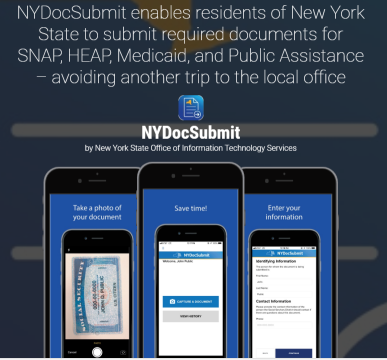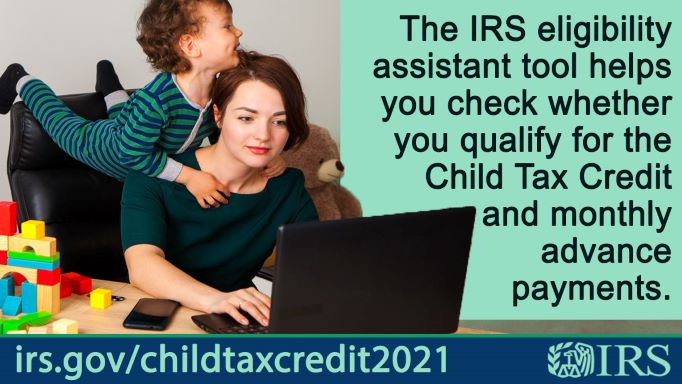

Note: The NYDocSubmit app is available.
Assistance Division
607.778.1100
The Assistance Programs Division is responsible for the administration of the benefits programs. These include SNAP (formerly known as Food Stamps), Temporary Assistance, Medicaid, Home Energy Assistance Program and Welfare to Work.
The Broome County Department of Social Services has detected dozens of applications submitted by Broome County residents that their benefits were stolen due to Electronic Benefits Transfer (EBT) “skimming.” This illegal process involves a device (skimmer) placed on top of a store’s card reading machine. The skimmer copies card and personal identification number (PIN) information from EBT cardholders. The stolen data is then used to access an individual’s EBT account and spend their Supplemental Nutrition Assistance Program (SNAP) and Temporary Assistance (TA) cash benefits.
All EBT cardholders should take these steps to protect their benefits.
Change their PIN immediately and remember to change it frequently.
Remember to protect their EBT card and PIN information.
Monitor their EBT account regularly to watch for unauthorized transactions.
If someone believes their benefits have been stolen, please immediately report the card stolen by calling 888-328-6399, visiting www.connectEBT.com, or through the connectEBT mobile app. For more information, please visit the website:
https://otda.ny.gov/workingfamilies/EBT-scam-alert.asp
Or contact the Broome County Case Integrity Unit at 607 778-2519.
Video: Act Fast: Protect Your EBT Benefits Against Skimming Thieves
New Common Benefit Identification Card (CBIC) Card Lock Feature
The purpose of this GIS (General Information System) message is to inform social services districts (districts) of the availability of a new feature which allows households to lock their Common Benefit Identification Card, or CBIC, commonly referred to as the Electronic Benefits Transfer (EBT) card. Households will now have the ability to lock their EBT card, which prevents their Supplemental Nutrition Assistance Program (SNAP) or Temporary Assistance (TA) cash benefits, or Home Energy Assistance Program (HEAP) benefits issued as cash to a household, from being accessed. Cardholders must then unlock the locked card to make a purchase using their SNAP or cash benefits. This new feature is intended to be used as a tool to help prevent theft of benefits through skimming or other fraudulent methods. Locking and unlocking the EBT card has no impact on Medicaid or other benefits issuances, including restricted payments directly to a landlord, utility, or other vendor. The card lock feature will roll out in multiple phases over the course of the next three months as described below.
The locking feature cannot prevent card information from being skimmed if a household’s card is used on a compromised device. However, if a card remains locked, remote fraudulent use of stolen information would be greatly restricted, limiting vulnerability to theft only at the time during which a household’s card is unlocked for purchasing.
Implementation
Phase 1: Beginning February 20, 2024, households will have the ability to lock and unlock their cards via the ConnectEBT mobile application (available on the: Google Play Store and Apple App Store). Cardholders must have a ConnectEBT account. If they have not already created an account, they can set one up using the mobile app. The cardholder must have activated their EBT card to access the lock/unlock feature. On the ConnectEBT mobile app home screen, a radio button will allow the cardholder to lock or unlock the card with one click. During this initial phase of the card lock rollout, the only option available to households will be to completely lock the card, preventing purchases, balance inquiries and most other transactions until the card is unlocked. Cardholders will receive an email immediately upon locking or unlocking their card, confirming the action they took.
Phase 1 will also allow cardholders to call the ConnectEBT helpline at 1-888-328-6399 to check the lock/unlock status and speak to a representative to unlock the card (only the unlock function is available through the helpline).
Phase 2: The complete card lock functionality will be expanded to the web-based ConnectEBT New York EBT client portal. In addition to the ConnectEBT mobile application, households will have the ability to perform the same locking and unlocking functions via their internet browser at www.connectebt.com/nyebtclient/. Phase 2 is expected to be completed within three months of phase 1 and districts will be notified when it becomes available.
Phase 3: An additional, and separate, locking feature to both the mobile application and the web-based client portal will be available, allowing households the option to lock their card for out-of-state transactions. Selecting this option will block all out-of-state transactions but continue to allow in-state transactions. Phase 3 is also expected to be completed within three months of phase 1.
New Cards
When a new card is ordered, the system does not retain the locked status of the previous card and all new cards are issued unlocked. Households will therefore need to relock any new cards they receive. OTDA advises districts to inform households that whenever a new card is ordered, it is delivered unlocked, regardless of whether the prior card was locked or not. If the cardholder would like the new card locked, they must lock it. Households should be encouraged to lock their new cards immediately after selecting a Personal Identification Number (PIN). The EBT card carrier, included in new card mailings, will contain information about the card lock feature.
Transaction Types:
The most common transactions that are rejected when a card is locked include: all purchases, balance inquiries, ATM withdrawals (TA cash benefits) and in-person returns/credits that require a card to be swiped.
The most common transactions that are still allowable when a card is locked include: returns/credits made online, and changes to an existing PIN.
Outreach
The OTDA website (www.otda.ny.gov/EBT-cardlock) includes information on the card lock feature. OTDA will also release an outreach flyer instructing cardholders how to use the new card lock feature. This flyer will be available in English and Spanish and made available on the OTDA website for districts to print, post and/or distribute to individuals receiving SNAP and/or TA cash benefits. As noted above, households receiving a new card will see information about the card lock feature on the EBT card carrier. Later this Spring, OTDA plans to notify households about this feature using text messages. Districts are encouraged to supplement this outreach with their own activities.
Conversion to New EBT Contractor
OTDA is in the process of converting from the current EBT contractor, Conduent, to Fidelity National Information Systems (FIS). Once FIS assumes control of EBT processing for New York State, the card lock feature will remain available to households. However, when conversion occurs, households will need to create a new online FIS cardholder account, and if they choose, download the FIS mobile application. There will be some minor differences in the card locking feature, which will be addressed in future guidance and outreach materials accordingly. Conversion to the new FIS EBT system is expected in summer of 2024.
Utilization
While card locking cannot completely prevent theft of information via skimming devices or other fraudulent methods, households whose EBT cards remain locked when not in use have a significantly lower chance of having their benefits stolen. OTDA encourages districts to explain to households (e.g., during eligibility interviews) the advantages of locking EBT cards when not in use.
Requests for replacement of stolen benefits, as defined in 23-ADM-07: Replacement Procedure for SNAP and/or TA Benefits Stolen via Skimming, Cloning, Phishing, or Other Fraudulent Methods, is not affected by a household’s use, or non-use, of the card lock feature. Replacement requests should continue to be evaluated consistent with the criteria set forth in the ADM, without regard to whether a household used the card lock feature or not.
As stated above, the card lock feature does not impact Medicaid.
Districts may contact the EBT Bureau with any questions by emailing: otda.sm.cees.ebt@otda.ny.gov.
SNAP
Food Stamps or SNAP (Supplemental Nutrition Assistance Program) is a federally funded program administered by the Department of Social Services for the United States Department of Agriculture. The goal of the program is to provide a higher level of nutrition to income eligible individuals and families by enhancing their ability to purchase food.
Eligibility for the program is determined by financial criteria. Those found eligible receive an EBT (electronic benefit card) which is scanned in any of 29 local grocery stores and farmers markets in Broome County.
More information regarding SNAP.
Temporary Assistance
Is the cash component of the Assistance Programs. Consumers receive a cash benefit either paid to them or to a vendor to pay for specific household needs. Household composition, resource and income levels will affect the amount of the shelter, heat, utility and other payments made for eligible families and individuals.
More information regarding Temporary Assistance.
Medicaid
Medicaid is a program that enables necessary health care coverage to eligible low income adults, children, pregnant women, elderly adults and people with disabilities in our community. The increasing numbers of elderly in the community as well as federal and state policy changes have continue to drive Medicaid caseload increases in Broome County as well as the NY State of Health Benefit Exchange.
More information regarding Medicaid.
Medicaid - Nursing Home/Chronic Care
Application assistance available.
No appointment required, walk-ins welcomed.
More information regarding Medicaid for Nursing Home/Chronic Care.
HEAP
The Broome County Social Services Home Energy Assistance Program (HEAP) is 607.778.1100. This is the Assistance Program’s Contact Center number. After you dial that number you press 8 to speak to someone in the HEAP unit M-F between the hours of 8am-4pm.
The emergency after-hours hotline number is 9-1-1. The Emergency Services Operator will direct your call.
More information regarding HEAP.
Employment Unit [formerly the Welfare to Work (WTW)]
Provides employment services including assessment, employment planning, job readiness classes, workfare, job placement, and case management for Temporary Assistance applicants and recipients.
Employment services are offered at our Main Street office. We strive to connect all Temporary Assistance applicants and recipients with employment opportunities to help them obtain and maintain self-sufficiency.
More information regarding Employment Services.
Changes to Child Tax Credit, IRS YouTube Video: https://youtu.be/KMe3q9N5UHY

Additional Broome County Resources:
Looking for other resources in Broome County? Click here to contact 211!
Child Abuse/Neglect 24 Hour State Hotline: Toll free dial '1' & then... 800-342-3720

